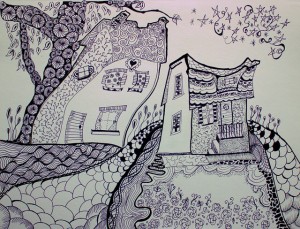Summer is fi nally here and I am excited about connecting my neurotransmitters with different evidence based practices so that I can inject different creative ideas combined with psychotherapeutic models.
nally here and I am excited about connecting my neurotransmitters with different evidence based practices so that I can inject different creative ideas combined with psychotherapeutic models.
So it’s time to go back to the virtual library and read voraciously. I came across these narrations: ” Jogging the Cogs: Trauma-Focused Art Therapy and Cognitive Behavioral Therapy with Sexually Abused Children” by Pifalo, T. (2007), and “Art Therapy: Journal of the American Art Therapy Association”, 24(4), 170-75; .
What I found interesting was the partnership of using creative art, trauma work and CBT. Even through it’s for a specific population, I am sure that it can be easily translated with any group as long as we understand the dynamic of the partnership. As I expand my tool box of activities and facilitation repertoire, I have come to realize that the modality of creative arts is flexible enough to absorb, modify and then deliver itself in a variety of ways using theories from different psychotherapeutic modalities. In my work using CBT, I often use worksheets as homework journaling thoughts and have found that words can sometimes be cumbersome and overwhelming for some. And I have been thinking on how to make it more accessible and interactive so that clients are not perturbed by the wordiness of the intervention. And that’s where creative arts come in as a value-added aspect of creative self-expression. When I use movement or a poetry or a piece of art or doodle as a way to record and translate the words into personal narratives, it seems to offer a channel for expression of experiences, and also supports the sensory-based understanding of how both the mind and body respond to anxiety and stress. And  from the book, I have gathered that art plus CBT plus trauma work have potential for bridging the gaps between the conscious and the unconscious. Pifalo who has conducted a number of research studies on trauma, using CBT and art therapy concludes the following:
from the book, I have gathered that art plus CBT plus trauma work have potential for bridging the gaps between the conscious and the unconscious. Pifalo who has conducted a number of research studies on trauma, using CBT and art therapy concludes the following:
“The visual nature of traumatic memory, the concrete graphic approach of art therapy, and the underlying structure of the cognitive behavioral approach create a powerful, efficient treatment model within which to achieve the goals of trauma focused therapy” (p.175).
By: Priya Senroy
*The views expressed by our authors are personal opinions and do not necessarily reflect the views of the CCPA